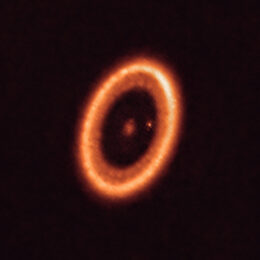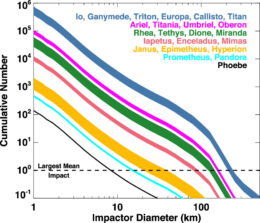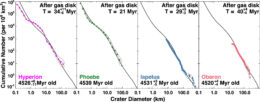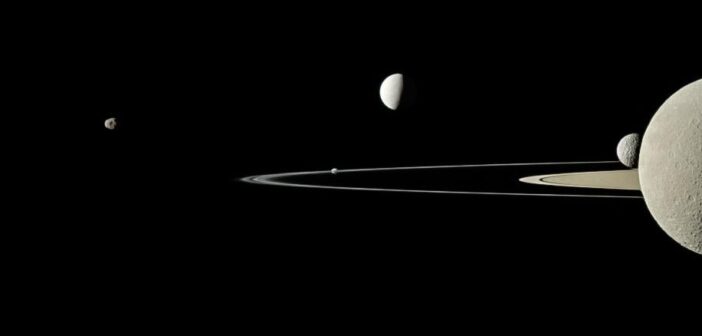The giant planets in our solar system — Jupiter, Saturn, Uranus, and Neptune — collectively host nearly 300 moons. What can craters tell us about how old these moons are and how they formed?
How Are Moons Made?

A submillimeter image of the PDS 70 planetary system. Between the outer ring of gas and the central star sits the Jupiter-like exoplanet PDS 70c, which is surrounded by a possible moon-forming circumplanetary disk. [ALMA (ESO/NAOJ/NRAO)/Benisty et al.; CC BY 4.0]
Crater counting provides a way to estimate the ages of satellite surfaces — placing limits on the ages of the objects themselves — and helps test these theories of satellite formation. To understand how the craters on a moon’s surface relate to the age of the surface, researchers had to imagine conditions in the solar system nearly 4.5 billion years ago, when things were far more chaotic than they are today.

Modeled cumulative number and size of impactors striking giant planet satellites since the beginning of the bombardment period. Satellites with similar collision probabilities are grouped together for clarity. Click to enlarge. [Bottke et al. 2024]
Shuffling the Solar System
A few tens of millions of years after the gaseous nebula that enveloped the young Sun and its budding planets dissipated, Neptune shook up the solar system. As Neptune migrated outward from the Sun, it crossed into a primordial disk of planetesimals, kicking 99.9% of these icy bodies into the solar system. (The remaining 0.1% of planetesimals remained behind and formed what is today known as the Kuiper Belt.) Thus began a long period of bombardment that is recorded on the surfaces of the many moons of the outer solar system.
Recently, William Bottke (Southwest Research Institute) and collaborators assigned ages to the surfaces of 26 satellites of Jupiter, Saturn, Uranus, and Neptune by modeling crater formation during this bombardment period.
To measure surface ages from the craters observed on these satellites today, the team modeled the sizes and numbers of craters forming due to bombardment on each satellite as a function of time. This model accounts for the relationship between the size of the impacting body and the size of the crater, changes in the sizes of the impacting bodies over time due to collisions between impactors, and other factors.
Missing Early History

Modeled (black lines) and observed (colored circles) crater size and frequency values for several small moons. The derived surface ages are listed in each panel. Bombardment begins at T = 20 million years after the gas disk disperses. Click to enlarge. [Bottke et al. 2024]
With early history erased by large impacts, it’s not possible to definitively state how these worlds formed — though Bottke’s team notes that for midsize and large moons, their model results are consistent with what’s expected for satellites forming in a disk around their host planets. Significant roadblocks exist for other theories. If future spacecraft can make sensitive gravity measurements of these worlds, revealing bombardment-induced changes to their crusts and interiors, it could reveal this hidden era of solar system history.
Citation
“The Bombardment History of the Giant Planet Satellites,” William F. Bottke et al 2024 Planet. Sci. J. 5 88. doi:10.3847/PSJ/ad29f4

